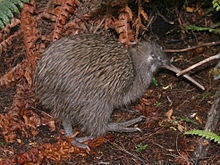Apteryx australis
| Southern brown kiwi | |
|---|---|
 |
|
| Stewart Island tokoeka | |
| Scientific classification | |
| Kingdom: | Animalia |
| Phylum: | Chordata |
| Class: | Aves |
| Order: | Apterygiformes |
| Family: | Apterygidae |
| Genus: | Apteryx |
| Species: | A. australis |
| Binomial name | |
|
Apteryx australis Shaw 1813 |
|
| Sub-species | |
|
A. a. lawryi (Rothschild, 1893) Checklist Committee 1953 |
|
 |
|
| The distribution of southern brown kiwi | |
| Synonyms | |
|
|
A. a. lawryi (Rothschild, 1893) Checklist Committee 1953
Stewart Island tokoeka
A. a. australis Shaw 1813
Haast tokoeka
The southern brown kiwi, tokoeka, or common kiwi,Apteryx australis, is a species of kiwi from New Zealand's South Island. Until 2000 it was considered conspecific with the North Island brown kiwi, and still is by some authorities.
Apteryx australis is based on Greek and Latin. Apteryx means "A-" without "pterux" wings, and "australis" from "auster" the south wind, and "-alis" relating to. Hence relating to the south wind is the meaning of australis, not Australia. The southern brown kiwi belongs to the kiwi family and it is a ratite, and a member of the order Struthioniformes. Like all ratites, its sternum has no keel, it is flightless, and it has a distinctive palate.
The southern brown kiwi is divided into two subspecies:
It has no preen gland, and its feathers have no aftershafts and no barbules. There are large vibrissae around its gape, and it has no tail, only a pygostyle. It has a length of 45 to 55 cm (18–22 in) and the female weighs 2.1 to 3.9 kg (4.6–8.6 lb) and the male weighs 1.6 to 2.8 kg (3.5–6.2 lb). Its bill is long and slender with a slight down-curve. Like other kiwis it is nocturnal. The colour of its plumage is rufous with some streaking.
Southern brown kiwi communicate vocally to aid in defending their territory. They will also sing duets with each other, with the male shrill "kee-wee" or "kee-kee" and the females hoarse " kurr kurr". Males are more vocal and they both call in an upright position with their legs stretched out and their bill pointing up.
...
Wikipedia

